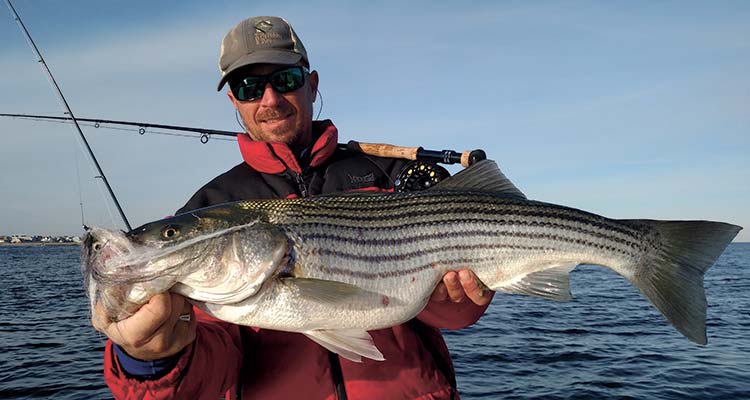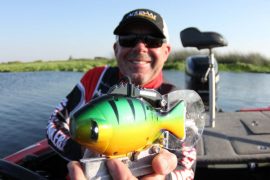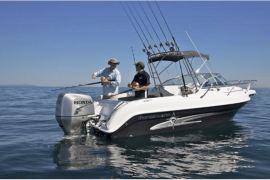
Pictured above: Ben Furimsky shows off a bass that inhaled his hand-tied, 14-inch bunker fly.
Catching a cow striper on the fly isn’t easy, but it can be done.
It’s no secret that the arrival of massive schools of bunker in May and June—and in recent years, in October and November too—make the New Jersey coast the place to be for anglers hunting trophy striped bass. To catch these big bass, most anglers use the conventional methods of snagging and dropping, live-lining, chunking, or casting metal-lip swimmers and pencil poppers. When the bass are feasting on bunker, hooking up with any of these techniques can be easy, both for boat and surf anglers—but what about the fly-fisher? Is it possible for fishermen to hook into 30- to 50-pound bass on the fly?
Yes! But getting the bass to find and strike your fly among thousands of 1-pound baitfish isn’t easy. If it was, we’d be seeing many more photographs of happy fly-fishermen with huge stripers draped across their laps. But it can be done.

Ups & Downs
There are two methods I use to target big bass on the fly. The first is the more traditional method of throwing 10- to 14-inch-long, synthetic flies to imitate adult bunker. I fish them by casting into the school of bunker and retrieving, keeping the fly near the surface with a floating or intermediate line. Retrieves should vary, since sometimes the bass want it fast and sometimes they want it slow. Varying the retrieve is important to see what the big fish want.
When casting and retrieving these flies near the surface, the key will be to get the boat in the right position so a cast can be made to feeding or breaking fish. This requires getting close enough so the angler can reach the fish because casting big flies can be difficult. It’s best to position the boat so it will drift into the fish with the engines turned off, so the throttle man must size up the wind, current, and the direction the school is moving.

When bass are blitzing on the surface, I also have success using big popping flies and chuggers on top. To catch a really big bass on the fly, one in excess of 40 pounds, this is the method to use. It’s similar to surfcasting with big pencil poppers. The goal is to make as much commotion as possible, which whips the bass into a frenzy and triggers them to strike out at the source of the disturbance. They don’t take a long look, as they might with a slowly fished subsurface fly.
When you know big bass are in the area—either by the marks on your fishfinder or from nearby trollers hooking up—but they aren’t showing on the surface, fishing deep with fast-sinking lines is the way to go. Getting down to the bass involves a little more than just casting out, letting the line sink, and retrieving. Instead, I cast out and then “stack mend” by…





